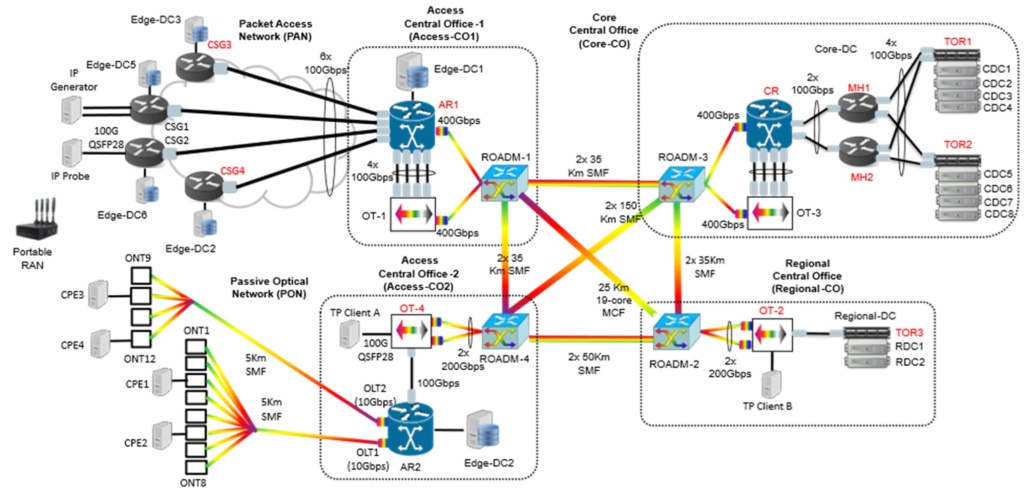ADRENALINE testbed ® – Experimental research testbed on high-performance and large-scale intelligent optical transport networks
The ADRENALINE testbed® is an open and disaggregated packet/optical transport network and edge/cloud computing infrastructure for Beyond 5G, 6G and IoT/V2X services supporting Network Function Virtualization (NFV) and cloud computing. It spans several network segments including access, metro/aggregation, and long-haul core. It uses Software Defined Networking (SDN) with open and standard interfaces and showcases the adoption and development of Open-Source Software and model driven development.
ADRENALINE® models a modern Telco infrastructure and enables experimental research in environments close to production systems, allowing researchers to deploy, validate and quantify the performance of implementations, control and management workflows, new methods, algorithms and heuristics for aspects such as path computation or resource allocation. The infrastructure encompasses access, regional and core central offices and variable sized data-centers that support a diversity of heterogeneous workloads and tasks, supporting delay and bandwidth sensitive services that characterize 5G and 6G ready networks.

From a technological perspective, key elements of ADRENALINE® include:
An SDN-enabled partially disaggregated optical network, composed of:
i) A photonic (flexi-grid DWDM) mesh network with 4 nodes and 5 bidirectional DWDM amplified optical links up to 150 km (overall 600 km of optical fiber); Ongoing work involves migrating selected elements to use optical wideband (including the usage of the L band in addition to the C band) for increased capacity, while introducing multi-granularity switching at the level of the optical nodes.
ii) A Spatial Division Multiplexing domain formed by 2 Spatial Cross Connect devices connected by a 25Km multi core fiber (19-core).
i) A photonic (flexi-grid DWDM) mesh network with 4 nodes and 5 bidirectional DWDM amplified optical links up to 150 km (overall 600 km of optical fiber); Ongoing work involves migrating selected elements to use optical wideband (including the usage of the L band in addition to the C band) for increased capacity, while introducing multi-granularity switching at the level of the optical nodes.
ii) A Spatial Division Multiplexing domain formed by 2 Spatial Cross Connect devices connected by a 25Km multi core fiber (19-core).
iii) Packet optical nodes with optical pluggable transponders providing aggregated 400G data rates for transporting traffic flows between the access and the core network segments. These nodes can be controlled by the SDN control plane and use a diversity of node operating systems like SONiC or IPinfusion OcNOS.
Heterogeneous access network technologies which are connected to the aggregation/metro infrastructure such as:
i) a Packet Access Node, based on IP Cell Site Gateways equipped with Edge DC capacities, and pluggable interfaces
ii) a Passive Optical Network tree formed by disaggregated Optical Network Terminals offering connectivity to several Customer Premises Equipment, and
iii) a pool of (OpenFlow-based) packet switches domain deployed on COTS and using Open vSwitch for the network connectivity needed by several Edge/Core data-center nodes;
Multiband, programmable SDN-enabled Sliceable Bandwidth Variable Transponders able to transmit multiple flows at variable data rate/reach up to 1 Tb/s are connected to the optical nodes, with advanced features such as SDN Control based on OpenConfig terminal data models, support for operational modes and multiband configuration as well as optical monitoring and telemetry.
A portable 5G-RAN to validate the usage of the ADRENALINE testbed® as a 5G and 6G ready transport network.
